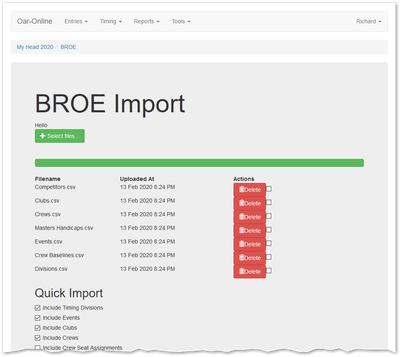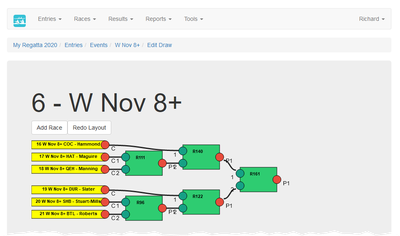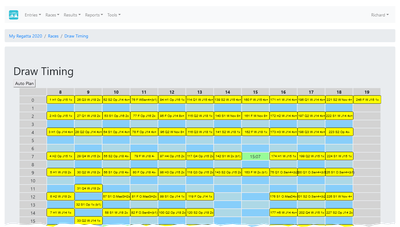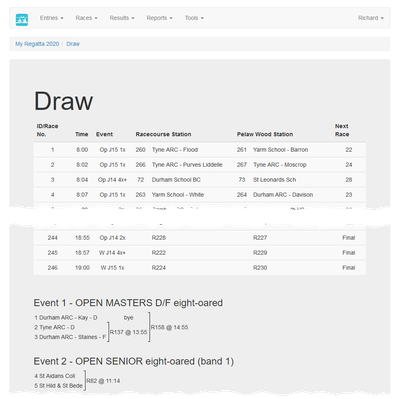Regatta Workflow
Regatta Workflow
Meeting Creation - initial meeting creation is done by a system administrator. This involves creating the empty competition and assigning permissions to the competition administrator. At the end of this step the competition admin will be able to import crews, prepare a draw and take the competition to fruition.
-
Meeting Settings - whilst Oar-Online defaults to a perfectly usable setup it is advisable to consider what is appropriate for your competition and to adjust accordingly. Specifically consider:
the number of lanes and any custom lane names;
the draw method/policy for the race;
timetabling strategy for race in the same round of an event;
whether crews should be named after the crew stroke rower or using the BROE crew names; and
various other labels and parameters.
-
Pre-BROE Import - before importing the competition data from BROE we generally advise that the entries team perform the usual audit tasks on entries received. Specifically:
ensure that all crews have appropriate competition;
any crews that do not have competition should be marked as rejected or withdrawn, any scratched crews will be included in the draw import and this is often not wanted during initial draw setup;
perform any event banding; and
move any masters handicap groupings into a single event.

BROE Import.
-
BROE Import - import of club, event, crew, competitor data from BROE is a simple task.
then upload the zip into Oar-Online to make it available for the data import.
use the quick import to pull in: draw divisions; clubs; events; crews; crew doubling; boat doubling; and auto-sort events.
Once imported review the overall import on the Entries Dashboard to ensure that the number of events, clubs, crews, divisions, etc, have been imported.
The imports can be repeated multiple times but refer to detailed documentation for details of procedures and pitfalls to be aware of.
-
Data Review/Tidy Up - once imported the BROE data will likely need some tidy up. Most of this involves relatively minor naming or formatting issues but some does involve review of data that is not 100% provided by BROE. Check:
that Masters' age categories have been correctly assigned. BROE only reports current crew roster age so the imported age may not reflect the actual intended handicap age or even reflect the age when crews were baselined at close of entries.
that the division order is appropriate.
that the event order is appropriate for draw/event numbering purposes. In the default case the event order is used to automatically arrange the draw/start-order. Getting this correct is important for streamlining draw production.
Other, mostly cosmetic, but advised cleanup is as follows:
review club names - The names provided by BROE tend to be very long and often have artifacts that are not desirable in a draw, e.g. "(Durham)". "Sunderland, City of, Rowing Club". Oar-Online allows three variations on the club name: a full name, a normal name and a shorter abbreviated name. It will try to use the longest name that will fit in a report field.
review event names - The space available for displaying event names is fairly limited and sometimes the short event name needs tweaking to make it fit in some report fields.
additional event details - Typically only needed for some Regatta competitions but Trophies, Previous Winners, Sponsors and long event names can be setup for inclusion in the formatted programme/draw/results.
crew names - check capitalisation of crew names when using stroke names or check the appropriateness of BROE crew names where clubs have customised a name.

Event Draw.
-
Regatta draw - in general we prefer to make the actual start-order draw an automated process. This simplifies the workflow and also can be argued to remove human bias from the overall process. However there are many cases where manual tweaks are required. Our recommended workflow is as follows:
decide on a regatta draw method in the initial meeting setup. In general we tend to favour/recommend the use of Priority Club Seeded for the draw. This places the highest pointed crews first in the start order and separates multiple crews from a single club.
automatically draw the competition and check that the actual draw is acceptable.
manually adjust event draws if required for instance if crews are moved between events and similar.
At this stage check that the draw status looks acceptable. It is much easier to correct the draw at this stage than it is to do once races are timetabled.

Regatta Timetabling.
-
Timetable the competition - a workable racing timetable is very competition specific many factors contribute to this and are not covered here (just yet!). The key is to ensure that the local environment can cope with the desired cadence of races and that inter-round and doubling separation are such that no significant problems arise.
setup race time slots - race slots are used to guide the timetabling algorithms and control the cadence of racing throughout the day. Ensure that sufficient time slots are available overall and for each division (if used). Also leave gaps for any planned breaks in racing whether that be inter-division breaks, tea intervals or times set aside for other water users.
decide on timetabling parameters - auto planning and checking is based around minimum times between rounds and associated ideal times. Choose these carefully to ensure that competitors get sufficient rest between rounds and that the minimum if sufficiently large to cope with common delays on race day.
-
auto plan and adjust the timetable - the auto planner will apply the desired timetabling parameters and attempt to produce an optimal solutions based on those. The extent to which a solution can be found depends on many factors not least of which is the degree to which the timetable is compressed together and approaching capacity limits.
Manual overrides can be applied to problematic/important races, or indeed the whole timetable, and these can be combined with the auto planner by marking those races as having a fixed race time.
-
check timetable constraints and workability - it is important to review, and if necessary revise, the timetable after planning. Many tools are provided to: list breached planning constraints; examine close round separation and doubling; and check overall timetable health.
It is also suggested that the full draw, at Reports -> Full Draw , is inspected to look for any issues.

Racing Programme.
-
Reports/Draw export - a number of stakeholders depend on the draw:
crew numbers to printers - if custom printed numbers are required produce the Crew Numbers by Club export and send to a provider such as Stacy who will include crew details of the respective race number.
draw for competitors/officials - in either PDF format.
BROE2 Custom Crew info - to inform BROE about the allocated crew race numbers and the names used in the draw. This allows searching within BROE using either of those fields.
Club Summary reports - for generating race number packs
Cox lists - for weighing in purposes listing minimum weights and cox name/membership number - import crew seat assignments for this report to contain cox details.
Crew membership lists - for control commission checking